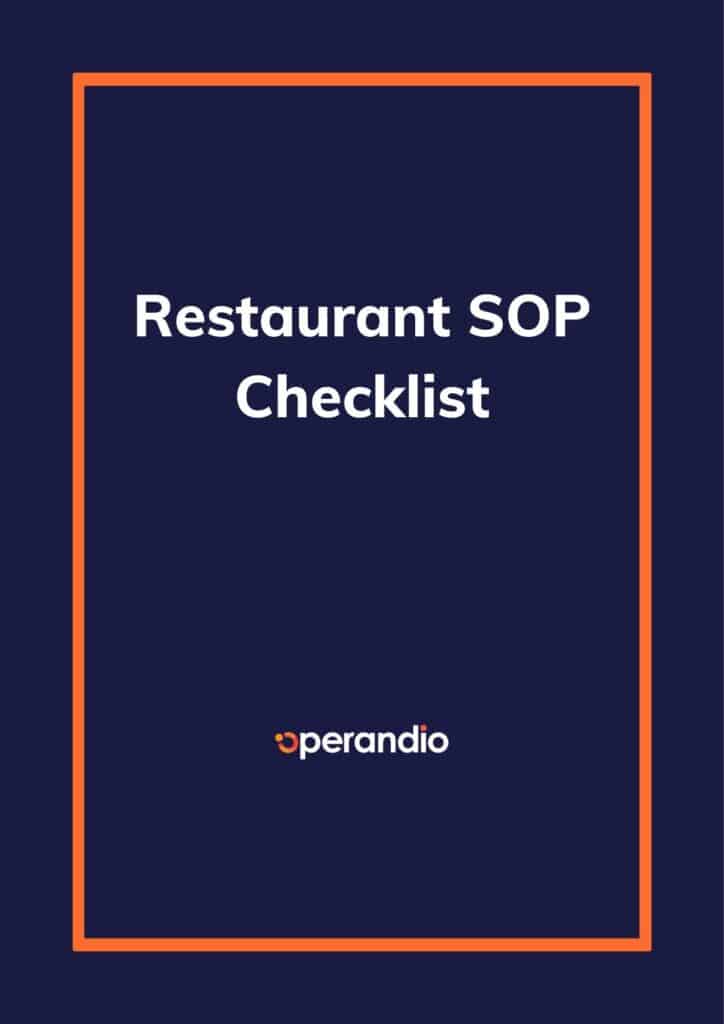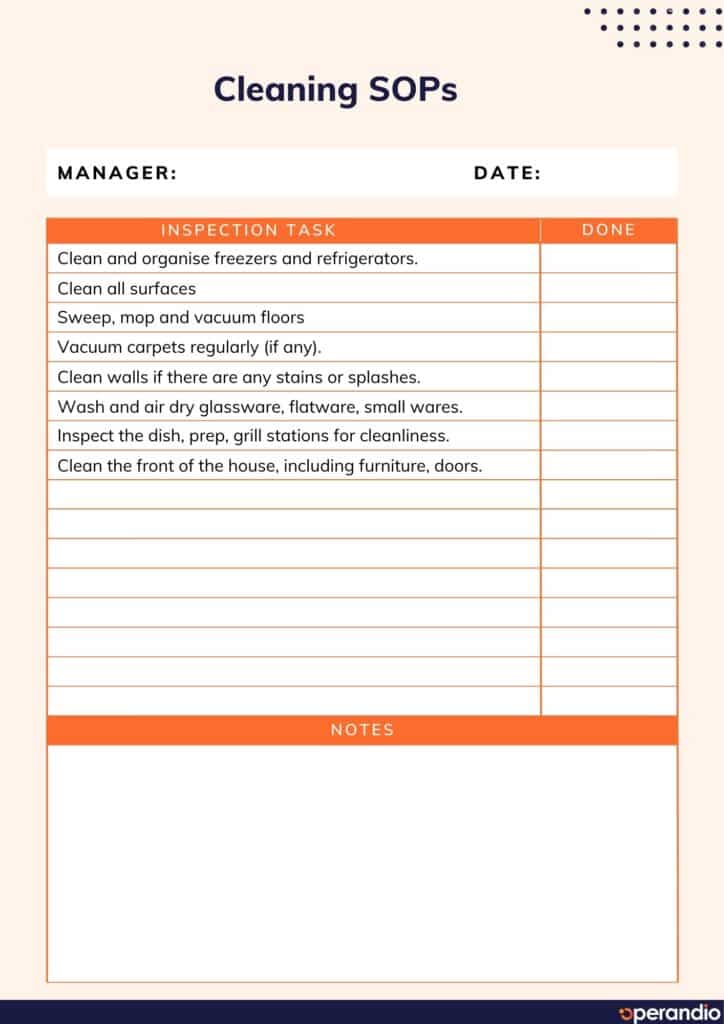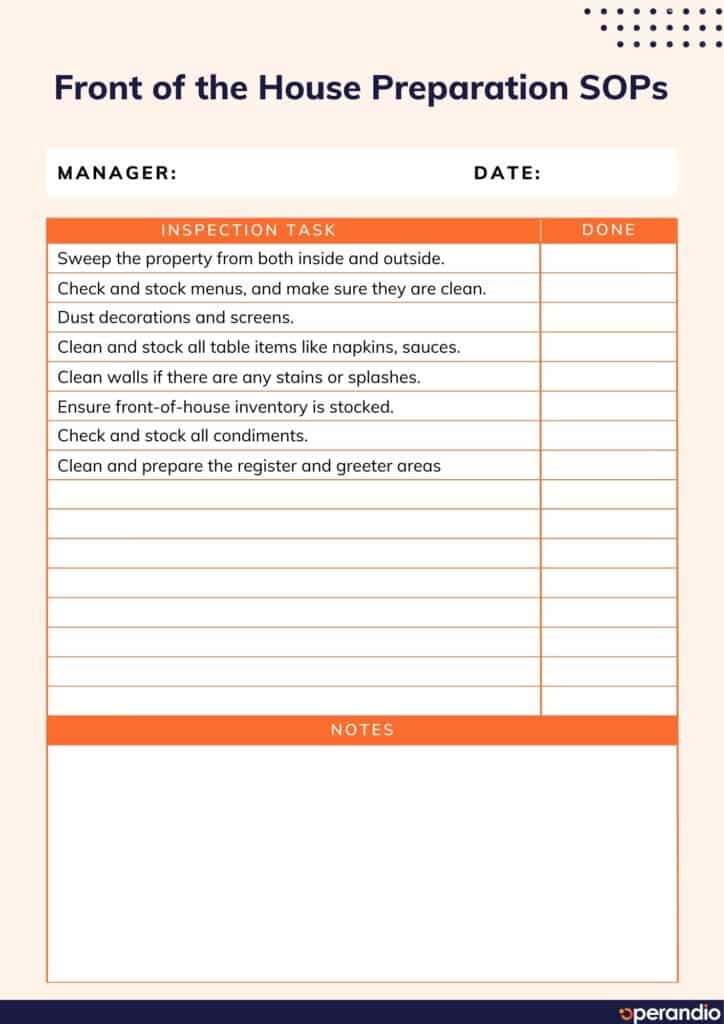What Is SOP in Restaurant: Checklist
SOP stands for ‘Standard Operating Procedure’, and they’re written instructions about the steps that you need to take to complete specific tasks in a restaurant. From food preparation to customer service, they help you ensure consistency and quality across different areas to run your business smoothly.
They provide clear guidance on how each task should be performed, including food safety protocols and hygiene standards. Additionally, you can also use them for training new employees or as refresher courses for existing ones.
Having an up-to-date SOP manual is essential for every restaurant business to run successfully. It helps you keep your employees informed about their duties and ensures that everyone is working together towards the same goals.



Restaurant SOP Checklist
Here’s a comprehensive SOP restaurant checklist that can help your employees understand how to satisfy work requirements safely.
Cleaning SOPs
- Remove trash and recycling and clean the areas around the bins if needed.
- Clean and sanitize surfaces of all registers and preparation stations.
- Clean fryers and ovens, and replace the oil as per the recommended schedule.
- Clean and organize freezers and refrigerators.
- Sweep and mop the floors daily, including under all equipment.
- Clean and scrape grills to ensure hygiene.
- Wipe down kitchen equipment, including stovetops.
- Sanitize all tables after each use.
- Sanitise boosters and high chairs after each use.
- Wipe down all counters.
- Vacuum carpets regularly (if any).
- Disinfect and sanitize restrooms, sinks, toilets, and empty garbage cans.
- Clean walls if there are any stains or splashes.
- Wash and air dry glassware, flatware, small wares, and utensils.
- Inspect the dish, prep, grill, food, and fry stations for cleanliness.
- Clean the front of the house, including furniture, doors, and windows.
Front of the House Preparation SOPs
- Sweep the property from both inside and outside.
- Ensure furniture, windows, and doors are clean and presentable.
- Check and stock menus, and make sure they are clean.
- Dust decorations and screens.
- Ensure restrooms are clean and stocked with toiletries.
- Clean and stock all table items like napkins, sauces, and salt & pepper.
- Check and stock all condiments.
- Ensure front-of-house inventory is stocked, and notify employees if there are any non-available items.
- Clean and prepare the register and greeter areas to make sure they’re organized and welcoming.
Back of the House Preparation SOPs
- Clean and store all utensils, pans, pots, and dishes properly.
- Check and adjust (if needed) the temperature of all dishwashers, refrigerators, and freezers to ensure food safety.
- Clean and sanitize all sinks after use to prevent contamination.
- Clean all work counters and surfaces to maintain hygiene.
- Clean stove and oven areas to ensure they are in good condition for use.
- Prepare and post daily prep checklists before each shift for efficient preparation.
- Follow food safety procedures when thawing frozen products.
- Ensure all items are organized and stocked to maintain efficiency in the kitchen.
Customer Service SOPs
- Conduct a final walkthrough of the dining room to ensure that it is clean and presentable.
- Ensure that the hosts/hostesses are available and ready to greet guests.
- Ensure that servers are prepared and ready to provide service to guests.
- The hosts/hostesses should greet and welcome guests within 60 seconds of their arrival in a friendly and positive manner.
- The hosts/hostesses should provide guests with accurate wait times to manage their expectations.
- Responsible employees should answer all phone calls promptly within 3-4 rings to avoid frustrating customers.
- Ensure that the table is properly set for the correct number of guests to create a welcoming atmosphere.
- Waiters/waitresses should offer menu features or specials and personal recommendations if needed to enhance the guest experience.
- Waiters/waitresses should provide customers with allergy information to avoid negative reactions. They should also repeat the order to ensure accuracy and prevent any mistakes in the order.
- Serve all soup, salad, drink, appetizer, and entree orders within a specified time frame (that you have set) to maintain customer satisfaction.
- Clear guest silverware, glassware, bowls, and plates within a specified time to maintain cleanliness and efficiency
- Reset the table quickly to prepare it for the next guest.
Bar Operation SOPs
- Wipe out bins and sinks containing old ice and ensure proper scoops are available.
- Stock ice bins with fresh ice daily.
- Cut all necessary fresh fruit and display it in clean containers.
- Stock and label any open containers of garnishes in clean containers.
- Stock fridges and shelves.
- Clean any build-up in soda and ice machines.
- Set up bars with stirs, picks, straws, speed trays, bar mats, and other bar tools that you use.
- Clean and sanitize the bar stools and countertops.
- Keep an eye on inventory levels and restock as needed.
- Monitor cleanliness and sanitation standards throughout the shift.
- Ensure all equipment is in good working order.
- Wipe down bottles that have been used with a clean, warm towel.
Purchasing and Ordering SOPs
- Verify current inventory on-hand and par-stock levels.
- Note order sheets with product numbers and item descriptions.
- Verify minimum order and order frequency.
- Consider the lead time for delivery.
- Allow for substitutions if possible.
- Consider discounts from other vendors and bulk ordering processes.
- Create purchase orders and verify prices from previous orders.
- Make sure that confirmation of orders is received.
- Ensure a steady supply of products is guaranteed by the supplier.
- Note the quality of customer service and ease of placing an order.
- Verify transportation/shipping to avoid delays and note any substitutions or issues with product availability.
- Inspect and approve receipt of purchases.
- Verify that the purchase order, invoice, and payment documents match.
- Maintain records of the purchase order and related documents.
- Search for and maintain records of supplier selection independently.
Receiving Orders SOPs
- Identify and train personnel for receiving products with written instructions provided.
- Clearly outline quality expectations to receiving personnel.
- Notify concerned units of substitutions.
- Communicate product specifications to receiving personnel.
- Identify space for receiving and preliminary storage.
- Ensure receiving equipment such as dollies and carts are available and clean.
- Verify the quality and condition of products received visually.
- Check the temperature of frozen products with a thermometer.
- Inspect dates of short-life products received.
- Re-weigh weight-based products to match the invoice.
- Verify that the purchase order and invoice match.
- Cross-check products received with invoices and mark them in the invoice. Consider exact prices, discounts per contract, and transportation/shipping taxes.
- Communicate issues with deliveries promptly (if any) to delivery personnel.
- Record and communicate shipment rejections to vendors according to procedures.
- Take pictures of poor quality and damaged products and inform the vendor.
- Apply credits per agreed methods and procedures.
- Store return products appropriately and advise your staff not to use them.
- Notify concerned units of any products that are shorted.
- Approve the invoices and make them ready for payment.
Storing SOPs
- Make sure dollies and carts are available and in excellent working order in order to distribute and move merchandise.
- Determine space for receiving and preliminary storage.
- Maintain a first-in, first-out policy and rotate items as needed.
- Meat should be stored in the bottom of refrigerators and freezers.
- Keep food at least six inches above the ground.
- Maintain an orderly and tidy storage place.
- At least twice a day, check the temperature of storage facilities.
- Before keeping perishable foods, be sure the dates are correct.
- Never overfill your freezers or refrigerators.
- Discard any food that seems to be spoiled or damaged.
- Train your employees to follow food safety procedures in order to prevent food-borne illnesses.
Hiring SOPs
- Confirm that the job application is completed.
- Ensure that all necessary forms are filled.
- Discuss the uniform policy with the applicant.
- Verify and make a photocopy of the food handler permit.
- Ensure that employee files are properly organized and secured.
- Discuss any restrictions or accommodations that may be necessary for the new hire.
- Discuss cell phone and internet policy with the new employee.
- Enrol the new hire in training programs.
Training New Hires SOPs
- Discuss with the new employee the guidelines and responsibilities for their position.
- Conduct a menu description test.
- Show and explain the register and point of sale system.
- Explain the cash flow procedures.
- Ensure that the new employee understands the menu.
- Explain the procedures for food delivery.
- Discuss the proper way to greet guests.
- Explain the telephone procedures.
- Discuss teamwork skills and policies.
Ensure that the new employee understands the side works [Link to Server Sidework Checklist].